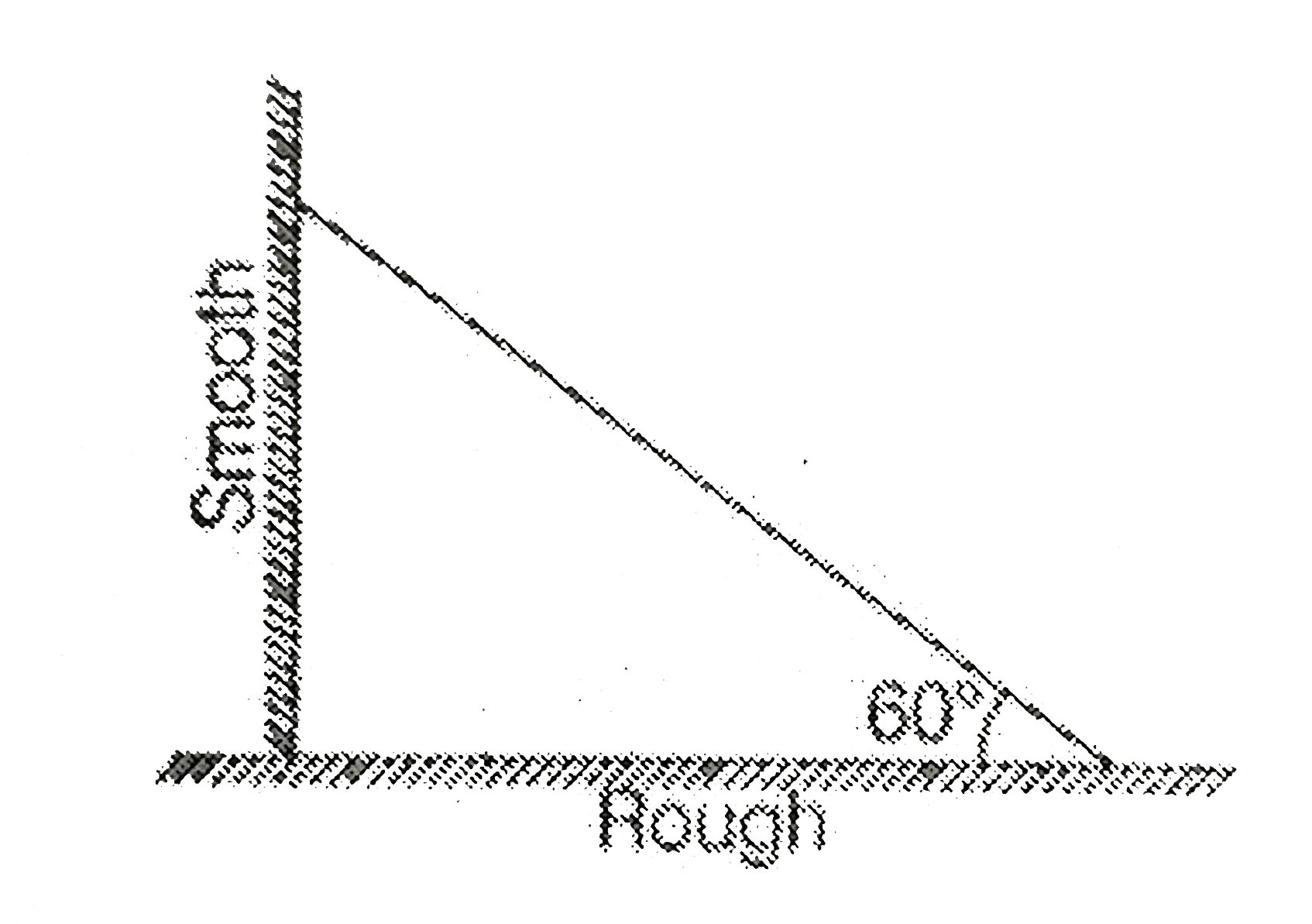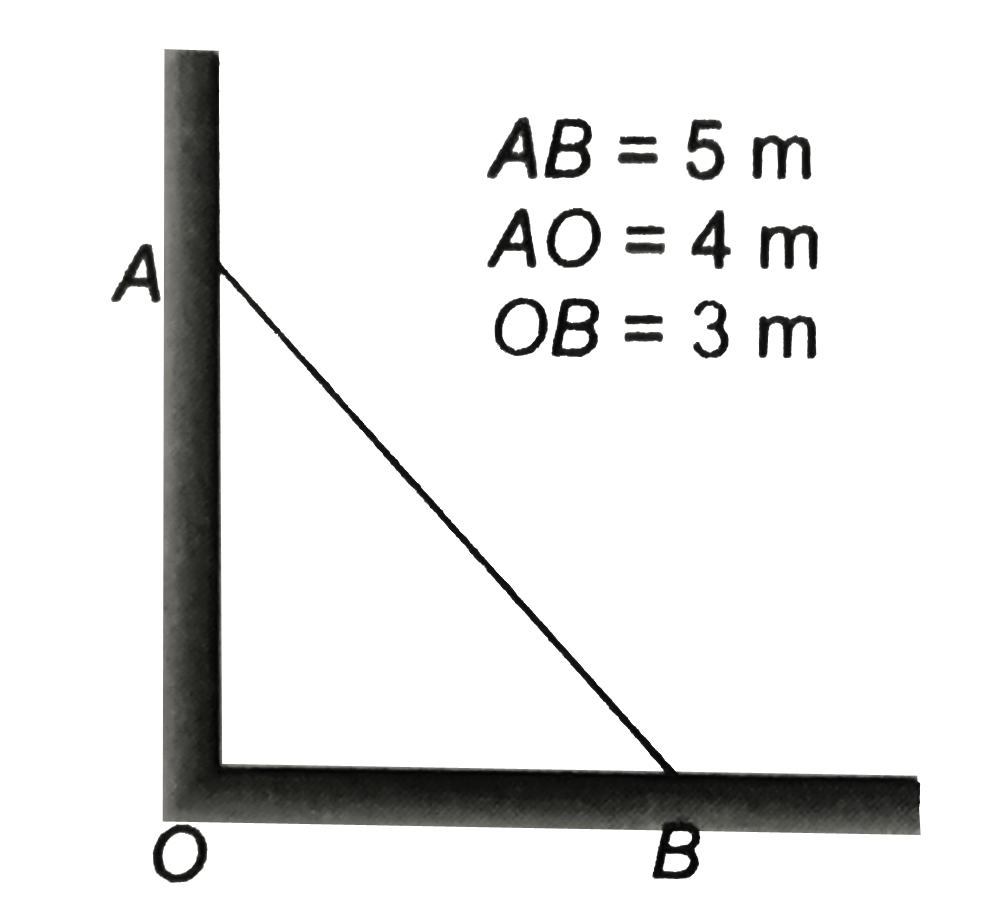A 4m long ladder weighing 25kg rests with its upper end against a smooth wall and lower end on rough ground.What should be the minimum coefficient of friction between the ground and the ladder for it to be inclined at 60∘ with the horizontal without slipping? (Takeg=10m/s2)
a. 0.19
b. 0.29
c. 0.39
d. 0.49
The correct Answer is:B
To solve the problem of determining the minimum coefficient of friction required for a 4 m long ladder weighing 25 kg to remain stable while inclined at an angle of 60∘ with the horizontal, we will follow these steps:
Step 1: Identify the forces acting on the ladder
1. Weight of the ladder (W): This acts vertically downward at the center of the ladder.
W=mg=25kg×10m/s2=250N
2. Normal forces:
- N1 acts vertically upward at the base of the ladder (ground).
- N2 acts horizontally from the wall (since the wall is smooth, it only provides a horizontal reaction).
3. Frictional force (F_r): This acts horizontally at the base of the ladder, opposing the tendency to slip.
Step 2: Set up the equilibrium equations
For the ladder to be in equilibrium:
- The sum of vertical forces must be zero.
- The sum of horizontal forces must be zero.
- The sum of moments about any point must also be zero.
Vertical Forces:
N2=W(1)
Horizontal Forces:
Fr=N1(2)
Step 3: Calculate moments about the base of the ladder
Taking moments about the base of the ladder (point O):
- The moment due to the weight of the ladder (acting at its center, 2 m from the base):
Moment due to W=W⋅(2cos(60∘))=250⋅(2⋅0.5)=250N⋅1=250Nm
- The moment due to the normal force from the wall:
Moment due to N1=N1⋅(4sin(60∘))=N1⋅(4⋅√32)=2√3N1
Setting the moments equal for equilibrium:
N1⋅(2√3)=250(3)
Step 4: Substitute N1 from equation (2) into equation (3)
From equation (2):
N1=Fr=μN2
Substituting N2=W from equation (1):
N1=μW=μ⋅250
Substituting this into equation (3):
μ⋅250⋅(2√3)=250
Dividing both sides by 250:
μ⋅2√3=1
Solving for μ:
μ=12√3=√36
Step 5: Calculate the numerical value of μ
Using √3≈1.732:
μ≈1.7326≈0.2887
Final Answer
The minimum coefficient of friction required is approximately:
μ≈0.29
1. Weight of the ladder (W): This acts vertically downward at the center of the ladder.
W=mg=25kg×10m/s2=250N
2. Normal forces:
- N1 acts vertically upward at the base of the ladder (ground).
- N2 acts horizontally from the wall (since the wall is smooth, it only provides a horizontal reaction).
3. Frictional force (F_r): This acts horizontally at the base of the ladder, opposing the tendency to slip.
For the ladder to be in equilibrium:
- The sum of vertical forces must be zero.
- The sum of horizontal forces must be zero.
- The sum of moments about any point must also be zero.
N2=W(1)
Fr=N1(2)
Taking moments about the base of the ladder (point O):
- The moment due to the weight of the ladder (acting at its center, 2 m from the base):
Moment due to W=W⋅(2cos(60∘))=250⋅(2⋅0.5)=250N⋅1=250Nm
- The moment due to the normal force from the wall:
Moment due to N1=N1⋅(4sin(60∘))=N1⋅(4⋅√32)=2√3N1
N1⋅(2√3)=250(3)
From equation (2):
N1=Fr=μN2
Substituting N2=W from equation (1):
N1=μW=μ⋅250
Substituting this into equation (3):
μ⋅250⋅(2√3)=250
Dividing both sides by 250:
μ⋅2√3=1
Solving for μ:
μ=12√3=√36
Using √3≈1.732:
μ≈1.7326≈0.2887
The minimum coefficient of friction required is approximately:
μ≈0.29
Topper's Solved these Questions
Similar Questions
A4m long ladder weighing 25kg rests with its upper and against a smooth wall and lower and on rought ground.What should be the minimum coefficient of friction between the ground and ladder for it to be inclined at 60∘ with the horizontal without slipping? (Takeg=10m/s2)
View SolutionA car goes on a circular horizontal road of radius 100 m. What should be the minimum coefficient of friction between the tyres and the road so that it completes the circle with velocity 10 m/s without slipping ? (Take g=10m/s2)
View SolutionA ladder of mass 10kg is held at reat against a smooth wall on a rough ground as shown in figure. The normal reaction between the wall and the ladder is
 View Solution
View SolutionA ladder of length 5m is placed against a smooth wall as shown in figure. The coefficient or friction is μ between ladder and ground. What is the minimum value of μ , If the ladder is not to slip?
 View Solution
View SolutionA ladder is kept at rest with is upper end against a wall and the lower end on the ground. The ladder is more like to slip when a mass stands on it at the top than at the bottom. Why ?
View SolutionA ladder of length l and mass m is placed against a smooth vertical wall, but the ground is not smooth. Coefficient of friction between the ground and the ladder is μ. The angle θ at which the ladder will stay in equilibrium is
View SolutionThe length of a uniform ladder of mass m is 1. It leans against a smooth wall making an angle θ with the horizontal. What should be the force of friction between the floor and ladder so that the ladder does not slip ?
View SolutionA ladder of length 5m is placed against a smooth wall as shown in figure. The coefficient or friction is μ between ladder and ground. What is the minimum value of μ , If the ladder is not to slip?
 View Solution
View SolutionA ladder of length 5m is placed against a smooth wall as shown in figure. The coefficient or friction is μ between ladder and ground. What is the minimum value of μ , If the ladder is not to slip?
 View Solution
View SolutionA uniform ladder which is 5m long has a mass of 25kg , leans with its upper end against a smooth vertical wall and its lower end on rough ground. The bottom of the ladder is 3m from the wall. Calculate the frictional force between the ladder and the ground . (g=10ms−2)
View Solution

